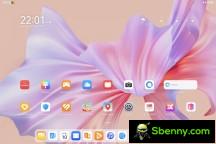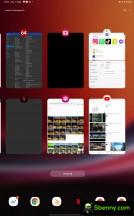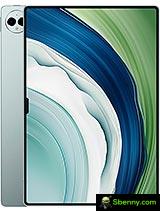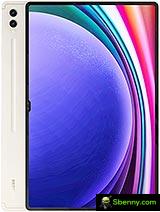The tablet segment may not be as popular as it once was, but that doesn’t mean there aren’t plenty of interesting devices out there. And if you don’t want to follow the Apple ecosystem, there’s a good chance you’ll end up with a Samsung or Huawei tablet. And today we’ll pit the latest and greatest tablets from these two manufacturers against each other.
The Huawei MatePad Pro 13.2 faces the Samsung Galaxy Tab S9 Ultra. Two large slates with high-end stylus support and optional keyboard covers. Both will be remembered for their notched screens, which certainly made them controversial among fans.
Summary:
Let’s start by comparing the complete technical data sheets.
Size comparison
The Galaxy Tab S9 Ultra is the largest tablet, featuring a significantly larger screen. It also looks more premium since it is made entirely of aluminum. Additionally, the Galaxy Tab S9 Ultra has an IP68 rating for dust and water resistance, while the Huawei model lacks any kind of ingress protection.
The included S-Pen charges on the back of the Galaxy, but there’s also a magnetic mount on the chassis. The optional Huawei M-Pencil only has one bed – both for charging and storage – and it’s on the chassis.
Overall, Samsung has done better in terms of design and usability.
View the comparison
Both tablets come with premium displays that will amaze you with their contrast and colors. The Galaxy one is larger, but with slightly lower resolution and refresh rate. The MatePad’s is a bit smaller, but with higher sharpness, refresh rate, and deeper colors (10 bit versus 8 bit). Both screens support HDR10, although Huawei’s support is unofficial.
The screen of the Huawei MatePad Pro 13.2 has the highest brightness – 770 nits vs. 642 nits in automatic mode e 626 nits vs. 353 nits with manual control.
Both screens offer accurate color reproduction.
The Huawei MatePad Pro 13.2 offers the highest refresh rate, but in our tests we could not confirm the claimed maximum refresh rate or the dynamic change. So, we have to take his word for it and trust that he is dynamic. On the other hand, the Galaxy Tab S9 Ultra supports 30Hz, 60Hz and 120Hz increments depending on the content.
Finally, the two tablets support HDR10 and are successfully recognized on Netflix and the like. To do this on MatePad Pro, however, you will have to use the Gbox versions of these apps.
Battery life
The MatePad Pro 13.2 is powered by a 10,100 mAh battery, while the Galaxy Tab S9 Ultra has an 11,200 mAh cell.
The Galaxy Tab S9 Ultra, thanks to its more power-efficient chipset and arguably screen, achieved a noticeably better active usage score in our battery life test. It performed better in all tests: calls, web, streaming and gaming.
Charging speed
There is a big difference between the two tablets when it comes to charging speed. The MatePad Pro 13.2 supports 88W fast charging and comes with that charger, while the Galaxy Tab S9 Ultra maxes out at 45W and comes without a charger.
It is therefore not surprising that the MatePad Pro 13.2 is twice as fast in terms of charging speed.
Test the speakers
The MatePad Pro 13.2 uses a 6-speaker system with 4 woofers and 2 tweeters just like the MatePad Pro 11. It also features ‘Huawei Sound’, which the official specs don’t go into detail about, but it sounds great. The Galaxy Tab S9 Ultra has four speakers with support for Dolby Atmos and they are quite loud.
The MatePad Pro 13.2 scored Excellent in our volume test and, in fact, sounds incredibly loud even when the volume is set to 50%! Even better, the sound quality is brilliant: deep bass, great vocals and well-presented high end.
The Galaxy Tab S9 Ultra also scored Excellent in our volume test and offers superb audio quality: the sound is rich from bass to treble.
Long story short, both tablets excel when it comes to speaker systems. We listened to them side by side and can conclude that the Huawei program has a slightly more powerful, bass-rich and sound-rich system.
Performance
The Huawei MatePad Pro 13.2 is the first device we come across with the Kirin 9000S chipset. Inside is an 8-core processor, with a Prime-like Taishan Main core clocked at 2.65 GHz, three Taishan Middle cores running at 2.15 GHz, and four power-efficient Cortex-A510 cores at 1 .5 GHz. Taishan cores support multi-threading and this is why some hardware apps detect the CPU as 12-core. The GPU is a custom Maleoon 910 MP4, which means it has four compute cores. It is clocked at 750 MHz.
The Samsung Galaxy Tab S9 Ultra is powered by the Snapdragon 8 Gen 2 for Galaxy. This chipset has 1 x 3.36 GHz Cortex-X3 main core, 2 x 2.8 GHz Cortex-A715 cores, 2 x 2.8 GHz Cortex-A710 mid cores and 3 x 2.0 Cortex-A510 power saving units GHz. The Adreno 740 GPU is clocked at 719. This model has faster UFS4.0 storage (50% or more) than UFS 3.1 on the MatePad and offers cellular capabilities up to 5G, in contrast to the Huawei MatePad Pro only Wifi. 13.2. Oh, and there’s a microSD slot too!
Predictably, while solid, the Huawei MatePad Pro 13.2 underperforms the Galaxy Tab S9 Ultra and its flagship Snapdragon hardware. The Galaxy Tab has an approximately 40% faster CPU and an almost 3x faster GPU.
The Galaxy Tab S9 Ultra has cutting-edge hardware and a more advanced processor, high-end graphics with ray tracing, and a better AI core. It is best suited for high-end gaming and has proven to be a tablet that offers great long-lasting performance.
Huawei’s hardware is far from bad, it’s just not flagship-level, but it would still handle most tasks without breaking a sweat.
Camera comparison
The Huawei MatePad Pro 13.2 has two cameras on the back, and two more on the front, inside a notch. On the back there is a 13 MP primary with 27 mm f/1.8 lens and autofocus and an 8 MP ultrawide with 13 mm f/2.2 lens and fixed infinity focus. The front setup contains a 16MP camera (Quad-Bayer sensor, fixed focus) with a 27mm f/2.2 lens and a 3D ToF unit for secure face unlock.
The Galaxy Tab S9 Ultra has two cameras on the back and there are two more cameras on the front, also within a notch. The rear cameras are the usual ones: a 13 MP primary with a 23 mm f/2.0 lens and autofocus and an 8 MP ultrawide with a 13 mm f/2.2 lens and fixed infinity focus. The front cameras are two 12MP imagers. The former has a 25mm f/2.2 lens, while the latter uses a 15mm f/2.4 lens for ultra-wide viewing. The focus is fixed for both front cameras.
Photos from the MatePad’s main camera have a better-developed center, but worse corners and inaccurate white balance with a visible red tint.
The MatePad’s ultrawide camera produces worse shots than the Galaxy’s with less detail, smeared corners, and often a visible reddish cast.
Selfies aren’t great on the MatePad: It has a 16MP Quad-Bayer camera that saves 4MP photos with little detail. On the other hand, the Galaxy Tab has true 12MP imagers that save detailed photos with accurate colors.




Galaxy Tab S9 Ultra: Home • Ultrawide • Selfie • Ultrawide selfie



MatePad Pro 13.2: Main • Ultrawide • Selfie
The Galaxy Tab S9 Ultra supports 4K video capture with all but the UW camera, while the MatePad only supports 4K video with the rear camera.
Videos shot with the Galaxy Tab are generally better. They are the ones with consistently accurate colors and more visible details.




S9 Ultra Video Card: Main (4K) • Ultrawide (1080p) • Selfie (4K) • Ultrawide Selfie (4K)



MatePad Pro 13.2 Video: Main (4K) • Ultrawide (1080p) • Selfie (1080p)
Software comparison
The MatePad Pro 13.2 runs HarmonyOS 4.0, the internal operating system, which integrates Android API 31 (Android 12). This latest version 4.0 is newer than the 3.0 version we’ve seen on previous MatePads, but is very similar in appearance. It is also similar to the company’s EMUI-labeled builds.
HarmonyOS 4 offers improved system widgets for the home screen, improved Super Device connectivity, and improved privacy and security. The OS still supports APK installations via Huawei’s AppGallery, Pure APK, or similar, and Gbox works great if you want to run Google apps.
You can launch apps in a split-screen view via a side menu, accessed by swiping in from one of the display’s edges and holding briefly to override the back gesture. Tapping an app from here opens a floating window of its own, and you can have two such windows open at the same time, with each launched successively minimizing one of the previous ones to a separate icon on the side, which in turn opens a separate window activity switch.




Home screen • Task picker • Pop-up apps • Multi-window
There is no DeX-like mode on MatePad, although its UI works like a desktop, and the only thing that’s not available here is putting files on the home screen, aka a real desktop. It would be nice if Huawei added this option in the future.
Oh, and while you’re in split screen, you can also have up to two pop-up windows on top, which brings the number of apps active at once up to four.
You can also copy and paste photos and text between windows by simply dragging them.
The Galaxy Tab S9 Ultra boots Android 13 with One UI 5.1. The interface supports tablet and DeX modes, and you can easily switch between them at any time.
By default, the S9 Ultra uses tablet view. Unless you manually switch to desktop mode (DeX), this is how you’ll use the slate. There are a couple of main differences between tablet and desktop views: the interface and icon scaling; the look and behavior of the home screen, and how multitasking is performed.
Multi-tasking in the tablet view occurs as on recent Galaxy smartphones – via the Task Switcher. In the activity switcher, just tap an app icon and you can choose between split-screen view and pop-up view. Not all apps support pop-up mode, but most can do split-screen view.





Home screen • Task picker • Pop-up view • Split view • Mixed view
DeX mode, not to be confused with the DeX wireless option, is a desktop-oriented interface for the Galaxy Tab S9 Ultra. You can turn on DeX view from Settings or Notification Center.
Once activated, the Galaxy Tab S9 Ultra is locked in landscape mode with a Windows-like desktop where you place your apps. All apps open in windowed mode, and at the top you’ll have the familiar dash/square/X trio. Most app windows support native fullscreen in DeX mode, but even if they don’t, the One UI will tell you this and will still properly maximize the app to fullscreen; it may simply need to be refreshed. We didn’t encounter any issues with the full-screen option on any app: whether compatible (no need to update) or non-optimized (needs restart). You can stack a large number of windows, just as you normally would on Windows and macOS. You can also dock windows in Split View, just like on Windows.




Desktop DeX • Windows • Snap Windows
The Galaxy Tab S9 Ultra offers much more mature software and multi-tasking options, even S-Pen ones, and we found that users with laptop-oriented needs would definitely prefer it over the Huawei device.
Verdict
The launch price of Huawei MatePad Pro 13.2 is 1,000 euros for the 256 GB Wi-Fi model. This is exactly the same price at which you can buy the 256GB Wi-Fi variant of the Galaxy Tab S9 Ultra. The MatePad comes with its own 88W power supply, while the Galaxy comes with an S-Pen instead. We consider the Huawei offer to be slightly more complete – you don’t need to start buying something immediately after opening the box.
Huawei has been one of the few companies to continue pushing new products into the high-end tablet segment. The Matepad Pro 13.2 continues the lineage with one of the best OLED screens for tablets, speaker systems, powerful operating system, super-fast charging and incredibly well-made original accessories. The potential problem, of course, is the lack of Google Mobile Services. And while Gbox provides working Play Store apps that require GMS, including Google’s Maps, Gmail, and YouTube, it still may not be enough for everyone.
The Galaxy Tab S9 Ultra is the largest and most powerful Android tablet at the moment. It uses everything Samsung has to offer in a tablet and does it well. The AMOLED screen is gorgeous, the Vision Booster is a great addition, and the Snapdragon 8 Gen 2 for Galaxy performs remarkably well under pressure. And with DeX mode, it’s a true laptop replacement.
The Tab S9 Ultra is an IP68-rated tablet with an incredibly thin metal unibody. The included S-Pen is also water resistant and of the highest quality: the active stylus with low latency input. We appreciate having it in the retail package.
Long story short: either get the Huawei deal for its bright and fast OLED and, better yet, even if the keyboard cover is optional. Or get the Galaxy Tab S9 Ultra because it’s simply the better deal: IP68-rated, more powerful, with DeX mode, and better battery life. And you can also have it with a SIM slot for 5G cellular connectivity. It’s not a difficult choice, right?

- The most colorful and brightest screen with a higher refresh rate.
- Faster charging with the included power adapter.
- The best speakers.
- Face ID.
Get MatePad Pro 13.2 for:

- The most powerful hardware with 5G connectivity.
- The best battery life.
- The aluminum unibody with IP68 protection rating.
- The full Android operating system with GMS and DeX support.
- The best cameras.
- The S-Pen bundled.







Start a new Thread